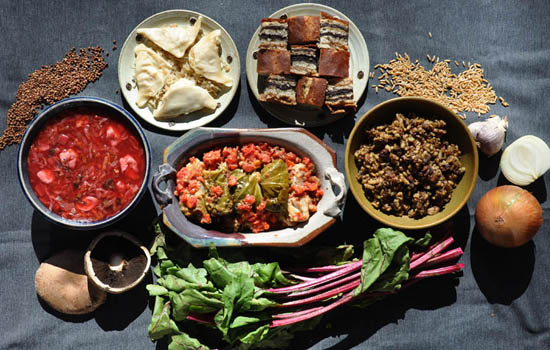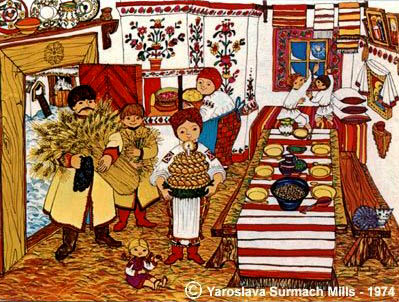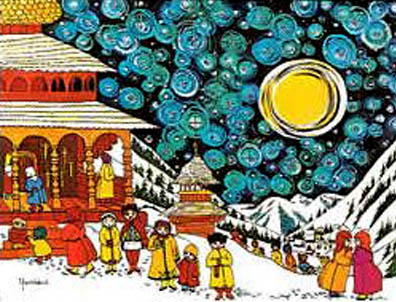A Ukrainian Christmas Eve
We often forget that vegetarian and vegan cuisine is not a new fad, but has deep roots across many different – and sometimes surprising – cultures. The Slavic peoples of central and eastern Europe, with their love of pork, poultry, and sour cream are not generally known for vegetarian, let alone vegan cooking. But the Eastern Orthodox church has many fast-days spread throughout the year in which the devout are required to abstain from eating (non-fish) meats, dairy, and eggs. As a result, these cultures have developed an extensive quasi-vegan diet.
To experience this cooking, let's visit Ukraine on the night of Christmas Eve.

This land, on the edge of the dry steppes of central Asia, was originally covered in grasslands with deep, rich, black soils, much like the prairies of the central USA. Soon after the invention of the plow, these began to be cultivated for a large number of small grains including wheat, rye, barley, and oats. This fertile land soon became the largest grain producer in Europe, supporting one of the densest agrarian populations on the continent. For over a thousand years various empires, including the Vikings, the Poles, the Lithuanians, the Golden Horde, the Cossacks, the Austrians, Tsarist Russia, the Third Reich, and the Soviet Union vied for control of Europe's breadbasket. Often these dominating foreign forces heavily taxed the peasants, taking much of their grain and leaving so little that famine became commonplace. Ukrainians fled west en masse into central Europe and ultimately the New World, searching for a new life. Today it is estimated that 10-20 million people of Ukrainian ancestry live outside of the country. In fact, it is likely that Jeff's own family history is tied to this diaspora: 'Nekola' is not a common or typical Czech surname, and seems likely to be a misspelling of the common Ukrainian given name 'Nikolai', suggesting that his family name may have been brought into the west by serfs fleeing oppression. Of course, ‘Nikolai’ honors Saint Nicholas, the 4th Century Bishop of Myrna (now part of Turkey), who is best known for his secret giving of gifts, such as placing coins in shoes left out over night.
 The Ukrainian people are deeply tied to their land. Ukrainian immigrants often took a small vial of soil with them so that they would always have a piece of their homeland with them, no matter where they lived. Farming and the food grown on those farms is a central part of Ukrainian culture and customs, and stretches back to long before Christianity was brought to the region by Vladimir the Great in 988. Perhaps nowhere else are grains and farming so revered, with these ancient traditions being seamlessly incorporated into Orthodox tradition. Even the Ukrainian flag, with the top half being blue and the bottom half yellow, mimics the vast plains of ripe grains stretching to the horizon under an open sky. The Ukrainian people are deeply tied to their land. Ukrainian immigrants often took a small vial of soil with them so that they would always have a piece of their homeland with them, no matter where they lived. Farming and the food grown on those farms is a central part of Ukrainian culture and customs, and stretches back to long before Christianity was brought to the region by Vladimir the Great in 988. Perhaps nowhere else are grains and farming so revered, with these ancient traditions being seamlessly incorporated into Orthodox tradition. Even the Ukrainian flag, with the top half being blue and the bottom half yellow, mimics the vast plains of ripe grains stretching to the horizon under an open sky.
Christmas Eve in Ukraine is celebrated in accordance with the Julian Calendar, which falls on the night of January 6 in the western Gregorian Calendar. The day is spent preparing the house for the celebration of the birth of Christ: First the house is cleaned and then instead of a Christmas Tree, sheaves of wheat and rye (called 'didukh' or grandfather) are placed under icons of the Virgin and Child. The holiday table is covered with a white tablecloth, under which is hidden a handful of hay (gathered from the first day of the summer's harvest) and some garlic cloves (to bring good health to the family over the upcoming year). On that table are spread the Holy Supper (Svyata Vechera), which is a Lenten meal consisting of 12 courses, one for each Apostle. One extra place setting is laid out to allow the spirits of the ancestors to also enjoy the feast with the living.
 Upon the glimpse of the first star of the evening, the family goes inside, gathers around the table, says a prayer, and enjoys the most sacred meal of the year. First to be tasted, in honor of good harvests and the richness of the land, is Kutia, a sacred Slavic dish of wheat berries, poppy seeds, nuts, dried fruits, and honey. Second, pieces of bread are torn from a braided loaf (kolach) and drizzled with honey. This is followed by a rich vegetarian borscht, stuffed cabbage leaves (holubtsi), filled dumplings (vareniki), assorted sweets, and some fish courses (which are allowed under Orthodox rules, making the meal not fully vegetarian or vegan). However, milk, eggs, butter, cream, and other meats are not to be consumed. Upon the glimpse of the first star of the evening, the family goes inside, gathers around the table, says a prayer, and enjoys the most sacred meal of the year. First to be tasted, in honor of good harvests and the richness of the land, is Kutia, a sacred Slavic dish of wheat berries, poppy seeds, nuts, dried fruits, and honey. Second, pieces of bread are torn from a braided loaf (kolach) and drizzled with honey. This is followed by a rich vegetarian borscht, stuffed cabbage leaves (holubtsi), filled dumplings (vareniki), assorted sweets, and some fish courses (which are allowed under Orthodox rules, making the meal not fully vegetarian or vegan). However, milk, eggs, butter, cream, and other meats are not to be consumed.
After the meal, neighborhood children gather holding a large wooden Star of Bethlehem lit by a central candle and an enormous sack, and then proceed house to house singing carols and receiving gifts. At midnight, families stream into their local church in their best embroidered clothes for the Christmas service.
Over the next week, we'll show you how to make your own Ukrainian Christmas Eve vegan meal. We've adapted the feast described by Anya von Bremzen and John Welchman in their classic 1990 Russian cookbook “Please to the Table.” Please check it out when you have a chance. Even though we'll limit ourselves to only 5 dishes rather than the traditional 12 (avoiding all fish dishes in the process), you'll still be able to experience a meal that not only celebrates the birth of Christ, but also your garden's harvest and the richness of the land on one of the longest nights of the year.
|
